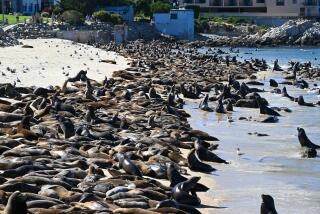Pair of Falcons Nesting on Bridge in San Diego
- Share via
SAN DIEGO — Forty-one years after the last peregrine falcon nest was seen in San Diego, a pair have begun raising a family on a shelf underneath the San Diego-Coronado Bay Bridge.
“It’s just amazing, particularly with the total lack of success we’ve had in the Channel Islands,” said Dan Brimm, a San Diego resident who coordinates a program that has released a dozen captive-hatched birds from Point Loma since 1984.
All but one of the birds released in San Diego--the female in the Coronado bridge pair--went north to make their homes, he said. Five pair of the endangered species have nested in the Channel Islands, off the Southern California coast, for the last two years, he said, but they have yet to hatch an egg.
3 Fuzzy Chicks Seen
In San Diego, however, atop a large pillar underneath the eastern end of the Coronado Bay Bridge, wildlife biologist Mark Pavelka spotted three fuzzy chicks earlier this month, officials of the California Department of Transportation said.
Caltrans allowed Pavelka access to a catwalk under the bridge after he saw one of the adult birds sitting on a pole on the bridge on April 13, said Steve Saville, a public affairs officer for Caltrans in San Diego.
The chicks are about 3 weeks old now, Brimm said. That they apparently are thriving above busy Harbor Drive and the Barrio Logan trolley terminal is testimony to how highly adaptable to urbanization the falcons are, he noted.
If the chicks can learn to fly without being hurt on the busy streets below, they might eventually become residents of ledges on downtown San Diego’s skyscrapers, Brimm said. That would treat downtown office workers to displays of falcons diving at up to 200 m.p.h. to catch pigeons in the air, as happens daily with a breeding pair that live on the Union Bank in Los Angeles.
4-Foot Wingspan
Adult peregrines are normally slate gray with a white throat and buff-colored breast, with a wingspan approaching four feet.
The last known instance of this endangered species nesting in the San Diego area occurred in 1948 and was photographed by Brimm, a longtime falcon watcher and a director of the Peregrine Fund. The private group has coordinated the release of about 3,000 peregrine falcons nationwide, 550 of them in California.
The California program has succeeded in establishing about 80 breeding pairs of the birds, most of them in the state’s central and northern sections. But Southern California has been a problem, apparently because of levels of chemicals in the birds’ food, Brimm said.
In the Channel Islands, for instance, dead embryos were found to contain high levels of toxic chemicals, including PCBs and dioxin, Brimm said.
Population Plummets
After decades of gradual decline, the nation’s peregrine population plummeted in the 1960s because of chemical contamination that caused females to produce eggs with shells so thin that they almost invariably broke. The main cause, the pesticide DDT, has since been banned in the United States.
Brimm said he suspects that the San Diego chicks did not suffer chemical contamination problems because their parents’ main food source is bridge-dwelling pigeons, which tend to eat food that comes from human sources, rather than from the wild. In the Channel Islands, falcons feed primarily on shore birds that ingest contaminants in the wild, he said.
More to Read
Sign up for Essential California
The most important California stories and recommendations in your inbox every morning.
You may occasionally receive promotional content from the Los Angeles Times.










